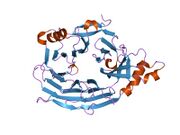Biology:Nuclear pore complex protein Nup133
 Generic protein structure example |
Nuclear pore complex protein Nup133, or Nucleoporin Nup133, is a protein that in humans is encoded by the NUP133 gene.[1][2][3]
Function
The nuclear envelope creates distinct nuclear and cytoplasmic compartments in eukaryotic cells. It consists of two concentric membranes perforated by nuclear pores, large protein complexes that form aqueous channels to regulate the flow of macromolecules between the nucleus and the cytoplasm. These complexes are composed of at least 100 different polypeptide subunits, many of which belong to the nucleoporin family. The nucleoporin protein encoded by this gene displays evolutionarily conserved interactions with other nucleoporins. This protein, which localizes to both sides of the nuclear pore complex at interphase, remains associated with the complex during mitosis and is targeted at early stages to the reforming nuclear envelope. This protein also localizes to kinetochores of mitotic cells.[3]
Interactions
NUP133 has been shown to interact with NUP107.[4][5]
References
- ↑ "UniProt". https://www.uniprot.org/uniprotkb/Q8WUM0/entry#names_and_taxonomy.
- ↑ "Novel vertebrate nucleoporins Nup133 and Nup160 play a role in mRNA export". The Journal of Cell Biology 155 (3): 339–54. Oct 2001. doi:10.1083/jcb.200108007. PMID 11684705.
- ↑ 3.0 3.1 "Entrez Gene: NUP133 nucleoporin 133kDa". https://www.ncbi.nlm.nih.gov/sites/entrez?Db=gene&Cmd=ShowDetailView&TermToSearch=55746.
- ↑ "The entire Nup107-160 complex, including three new members, is targeted as one entity to kinetochores in mitosis". Molecular Biology of the Cell 15 (7): 3333–44. Jul 2004. doi:10.1091/mbc.E03-12-0878. PMID 15146057.
- ↑ "An evolutionarily conserved NPC subcomplex, which redistributes in part to kinetochores in mammalian cells". The Journal of Cell Biology 154 (6): 1147–60. Sep 2001. doi:10.1083/jcb.200101081. PMID 11564755.
Further reading
- "The nuclear pore complex: from molecular architecture to functional dynamics". Current Opinion in Cell Biology 11 (3): 391–401. Jun 1999. doi:10.1016/S0955-0674(99)80055-6. PMID 10395558.
- "Function and assembly of nuclear pore complex proteins". Biochemistry and Cell Biology 77 (4): 321–9. 1999. doi:10.1139/bcb-77-4-321. PMID 10546895.
- "A "double adaptor" method for improved shotgun library construction". Analytical Biochemistry 236 (1): 107–13. Apr 1996. doi:10.1006/abio.1996.0138. PMID 8619474.
- "Large-scale concatenation cDNA sequencing". Genome Research 7 (4): 353–8. Apr 1997. doi:10.1101/gr.7.4.353. PMID 9110174.
- "An evolutionarily conserved NPC subcomplex, which redistributes in part to kinetochores in mammalian cells". The Journal of Cell Biology 154 (6): 1147–60. Sep 2001. doi:10.1083/jcb.200101081. PMID 11564755.
- "The conserved Nup107-160 complex is critical for nuclear pore complex assembly". Cell 113 (2): 195–206. Apr 2003. doi:10.1016/S0092-8674(03)00235-6. PMID 12705868.
- "The entire Nup107-160 complex, including three new members, is targeted as one entity to kinetochores in mitosis". Molecular Biology of the Cell 15 (7): 3333–44. Jul 2004. doi:10.1091/mbc.E03-12-0878. PMID 15146057.
- "Structural and functional analysis of Nup133 domains reveals modular building blocks of the nuclear pore complex". The Journal of Cell Biology 167 (4): 591–7. Nov 2004. doi:10.1083/jcb.200408109. PMID 15557116.
- "Phosphoproteome analysis of the human mitotic spindle". Proceedings of the National Academy of Sciences of the United States of America 103 (14): 5391–6. Apr 2006. doi:10.1073/pnas.0507066103. PMID 16565220. Bibcode: 2006PNAS..103.5391N.
- "A probability-based approach for high-throughput protein phosphorylation analysis and site localization". Nature Biotechnology 24 (10): 1285–92. Oct 2006. doi:10.1038/nbt1240. PMID 16964243.
- "Global, in vivo, and site-specific phosphorylation dynamics in signaling networks". Cell 127 (3): 635–48. Nov 2006. doi:10.1016/j.cell.2006.09.026. PMID 17081983.
- "Purification, crystallization and preliminary X-ray analysis of a Nup107-Nup133 heterodimeric nucleoporin complex". Acta Crystallographica Section F 63 (Pt 9): 816–8. Sep 2007. doi:10.1107/S1744309107040523. PMID 17768364.
 |


